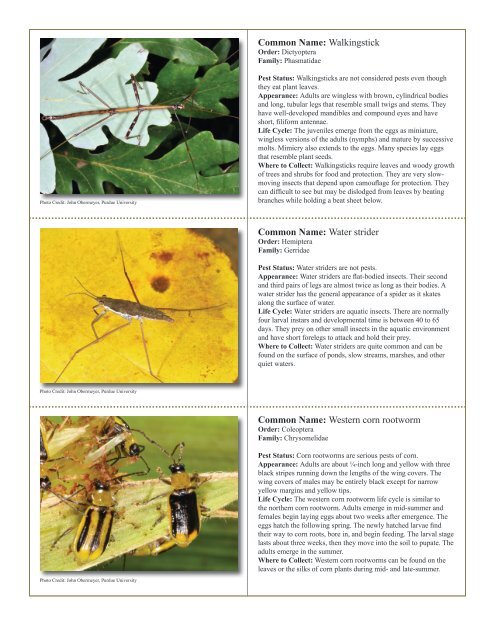to download pdf - Purdue Extension Entomology - Purdue University
to download pdf - Purdue Extension Entomology - Purdue University
to download pdf - Purdue Extension Entomology - Purdue University
You also want an ePaper? Increase the reach of your titles
YUMPU automatically turns print PDFs into web optimized ePapers that Google loves.
Common Name: Walkingstick<br />
Order: Dictyoptera<br />
Family: Phasmatidae<br />
Pho<strong>to</strong> Credit: John Obermeyer, <strong>Purdue</strong> <strong>University</strong><br />
Pest Status: Walkingsticks are not considered pests even though<br />
they eat plant leaves.<br />
Appearance: Adults are wingless with brown, cylindrical bodies<br />
and long, tubular legs that resemble small twigs and stems. They<br />
have well-developed mandibles and compound eyes and have<br />
short, filiform antennae.<br />
Life Cycle: The juveniles emerge from the eggs as miniature,<br />
wingless versions of the adults (nymphs) and mature by successive<br />
molts. Mimicry also extends <strong>to</strong> the eggs. Many species lay eggs<br />
that resemble plant seeds.<br />
Where <strong>to</strong> Collect: Walkingsticks require leaves and woody growth<br />
of trees and shrubs for food and protection. They are very slowmoving<br />
insects that depend upon camouflage for protection. They<br />
can difficult <strong>to</strong> see but may be dislodged from leaves by beating<br />
branches while holding a beat sheet below.<br />
Common Name: Water strider<br />
Order: Hemiptera<br />
Family: Gerridae<br />
Pest Status: Water striders are not pests.<br />
Appearance: Water striders are flat-bodied insects. Their second<br />
and third pairs of legs are almost twice as long as their bodies. A<br />
water strider has the general appearance of a spider as it skates<br />
along the surface of water.<br />
Life Cycle: Water striders are aquatic insects. There are normally<br />
four larval instars and developmental time is between 40 <strong>to</strong> 65<br />
days. They prey on other small insects in the aquatic environment<br />
and have short forelegs <strong>to</strong> attack and hold their prey.<br />
Where <strong>to</strong> Collect: Water striders are quite common and can be<br />
found on the surface of ponds, slow streams, marshes, and other<br />
quiet waters.<br />
Pho<strong>to</strong> Credit: John Obermeyer, <strong>Purdue</strong> <strong>University</strong><br />
Common Name: Western corn rootworm<br />
Order: Coleoptera<br />
Family: Chrysomelidae<br />
Pest Status: Corn rootworms are serious pests of corn.<br />
Appearance: Adults are about ¼-inch long and yellow with three<br />
black stripes running down the lengths of the wing covers. The<br />
wing covers of males may be entirely black except for narrow<br />
yellow margins and yellow tips.<br />
Life Cycle: The western corn rootworm life cycle is similar <strong>to</strong><br />
the northern corn rootworm. Adults emerge in mid-summer and<br />
females begin laying eggs about two weeks after emergence. The<br />
eggs hatch the following spring. The newly hatched larvae find<br />
their way <strong>to</strong> corn roots, bore in, and begin feeding. The larval stage<br />
lasts about three weeks, then they move in<strong>to</strong> the soil <strong>to</strong> pupate. The<br />
adults emerge in the summer.<br />
Where <strong>to</strong> Collect: Western corn rootworms can be found on the<br />
leaves or the silks of corn plants during mid- and late-summer.<br />
Pho<strong>to</strong> Credit: John Obermeyer, <strong>Purdue</strong> <strong>University</strong>
















